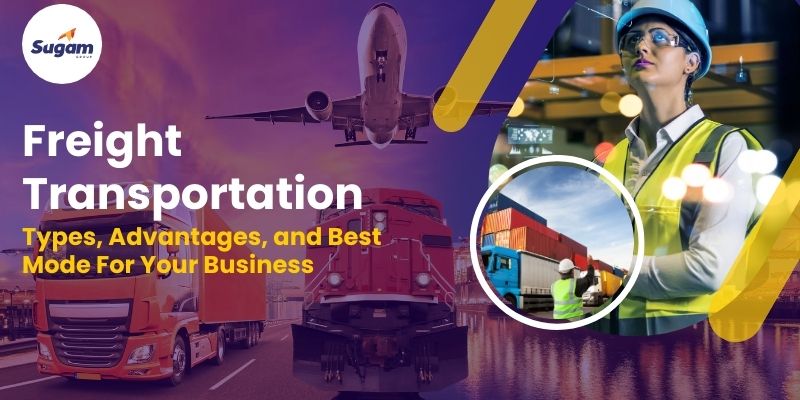Freight Transportation: Types, Advantages, and Best Mode For Your Business
Whether you’re a small business owner looking to ship products to customers, or a logistics professional responsible for managing a supply chain, freight transportation is one of the crucial requirements to grow. This blog will provide valuable insights and practical tips for optimizing your freight transportation strategy. It will also highlight the advantages and disadvantages of each mode of transportation, and provide guidance on how to choose the best mode for your business based on factors such as cost, speed, reliability, and environmental impact.
What is Freight Transportation?
Freight transportation is the movement of goods and materials from one place to another using various modes of transportation such as trucks, ships, aeroplanes, and trains. It is a critical aspect of the global economy and plays a vital role in the supply chain management of businesses across various industries.
Freight transportation is an essential component of international trade, allowing products to be transported from manufacturers to retailers and consumers all over the world. The type of transportation mode used depends on the distance of the shipment, the nature of the goods, and the urgency of the delivery.
Contact Us For Freight Transportation
Advantages of Freight Transportation
Freight transportation offers several advantages for businesses, including improved accessibility, greater efficiency, cost-effectiveness, flexibility, improved reliability, and reduced environmental impact. Understanding these benefits can help businesses make informed decisions about their transportation needs and optimize their supply chain management.
Improved Accessibility
Freight transportation provides businesses with greater accessibility to customers and markets that may be otherwise difficult to reach. With a range of transportation modes available, such as road, rail, air, and ocean/ship, businesses can choose the most suitable option based on their specific needs and requirements. This increased accessibility can help businesses expand their reach and grow their customer base.
Greater Efficiency
Freight transportation is faster and more efficient than other methods of transporting goods, allowing businesses to move products quickly and efficiently. With defined schedules and tracking systems, businesses can plan and manage their supply chains more effectively, resulting in increased efficiency and reduced costs.
Cost-Effective
Freight transportation can be a cost-effective option, particularly for large or heavy goods that require specialized equipment and handling. With advances in transportation technology and logistics, businesses can optimize their supply chain management and reduce costs by choosing the most appropriate transportation mode and route.
Increased Flexibility
Freight transportation offers a high degree of flexibility, with various modes of transportation and routes available. This flexibility allows businesses to choose the most suitable transportation option for their specific needs, such as time sensitivity, cost, or destination. Multimodal transportation, which involves the use of multiple transportation modes, provides even greater flexibility.
Improved Reliability
Freight transportation is generally reliable, with defined schedules and tracking systems that allow businesses to plan and manage their supply chains more effectively. With the ability to track shipments in real-time, businesses can better manage inventory and ensure that products are delivered on time.
Reduced Environmental Impact
Advances in transportation technology and alternative fuels have made freight transportation more environmentally friendly, reducing the impact on the environment. For example, electric trucks and ships, as well as biofuels, can significantly reduce carbon emissions and help businesses meet their sustainability goals.
Also Read:- Express Shipping Vs Regular Shipping
Types of Freight Transportation
There are several types of freight transportation, including road, rail, air, ocean/ship, and multimodal transport, each with its own advantages and disadvantages. Understanding these modes of transportation can help businesses make informed decisions about the best way to move their goods. Let’s explore each one of them.
I. Road Transport
Road transport is the most common mode of freight transportation, and it involves the use of trucks and other vehicles to transport goods overland. One of the main advantages of road transport is its flexibility, as it allows for door-to-door delivery and can reach almost any destination. However, road transport can be affected by traffic congestion and adverse weather conditions, which can cause delays and increase transportation costs.
The types of vehicles used in road transport can vary depending on the size and weight of the cargo being transported. For example, small vehicles like vans and pickups can be used for local deliveries, while larger vehicles like tractor-trailers are better suited for long-distance transport. It’s important to note that there are regulations and safety measures that apply to road transport, such as weight limits, speed limits, and driver regulations.
II. Rail Transport
Rail transport involves the use of trains to transport goods over long distances. One of the main advantages of rail transport is its ability to transport large quantities of goods efficiently and cost-effectively. It’s also more environmentally friendly than road transport, as it produces fewer emissions. However, rail transport can be less flexible than road transport, as it requires a network of rail lines and terminals.
There are different types of rail transport, including intermodal transport, which involves the use of containers that can be transferred between trains and trucks. There are also regulations and safety measures that apply to rail transport, such as regulations for transporting hazardous materials and safety measures for loading and unloading cargo.
III. Air Transport
Air transport is the fastest mode of freight transportation and involves the use of airplanes to transport goods over long distances. It’s ideal for urgent and time-sensitive shipments, but it can also be the most expensive mode of transportation. Air transport can also be affected by weather conditions and flight cancellations, which can cause delays and disruptions to supply chains.
There are different types of air transport, including air cargo, which involves the use of specialized cargo planes to transport goods. There are also regulations and safety measures that apply to air transport, such as regulations for transporting dangerous goods and safety measures for cargo loading and unloading.
IV. Ocean/Ship Transport
Ocean/ship transport involves the use of ships to transport goods over long distances, usually between countries or continents. It’s the most cost-effective mode of transportation for long-distance shipments, but it can also be the slowest. Ocean/ship transport is ideal for transporting large quantities of goods, such as raw materials and finished products.
There are different types of ships used in ocean/ship transport, including container ships, bulk carriers, and tankers. There are also regulations and safety measures that apply to ocean/ship transport, such as regulations for transporting hazardous materials and safety measures for cargo loading and unloading.
V. Multimodal Transport
Multimodal transport involves the use of multiple modes of transportation, such as road, rail, air, and ocean transport, to transport goods from one location to another. It’s ideal for complex supply chains that require multiple modes of transportation to reach their destination. Multimodal transport can provide greater flexibility and cost-effectiveness than using a single mode of transportation.
There are different types of multimodal transport, including intermodal transport, which involves the use of multiple modes of transportation to transport goods using standardized containers. There are also regulations and safety measures that apply to multimodal transport, such as regulations for transporting hazardous materials and safety measures for cargo loading and unloading.
What is the best way to transport goods?
The best way to transport goods depends on several factors such as the type of goods being transported, distance, time sensitivity, and budget. Each mode of transportation has its advantages and disadvantages, so it’s important to consider these factors when deciding on the best way to transport goods. For example, air transportation is faster but more expensive, while sea transportation is slower but more cost-effective for long distances. Businesses may also consider multimodal transportation, which involves the use of multiple transportation modes, to optimize their supply chain management and reduce costs. Ultimately, the best way to transport goods is the one that meets the specific needs and requirements of the business.
Conclusion
In conclusion, choosing the right mode of freight transportation for your business can have a significant impact on your supply chain management and overall success. By understanding the different types of transportation available, their advantages, and limitations, businesses can make informed decisions on the best way to transport their goods. Whether it’s road, rail, air, ocean/ship, or multimodal transportation, each method has its unique benefits and trade-offs. By considering factors such as the type of goods being transported, distance, time sensitivity, and budget, businesses can choose the most efficient and cost-effective transportation mode for their specific needs. Ultimately, by optimizing their transportation logistics, businesses can improve their operations, reduce costs, and better meet the needs of their customers.
Why Choose Freight Transportation From Sugam Group?
In the past 50 years, Sugam Group has become India’s leading logistics provider with firm knowledge and experience of freight transportation. We deliver excellence in our services with well established international boundaries of transportation & 3PL solutions across India, Nepal, Bhutan & Bangladesh. With over 1 Lac customers annually, we have 1,00,000+ sq. ft. area of warehouse space and 250+ offices in SAARC region along with 500+ GPS enabled vehicles.
FAQs
What is the meaning of freight transport?
Freight transport refers to the movement of goods or cargo from one place to another through different modes of transportation such as road, rail, air, or sea. It plays a crucial role in supply chain management and logistics, enabling businesses to transport their goods efficiently and effectively.
What is an example of freight transportation?
Examples of freight transportation include trucks carrying goods on highways, trains transporting cargo on rail tracks, ships moving containers across oceans, and planes transporting packages through the air.
What are the 5 modes of freight transportation?
The five modes of freight transportation are road, rail, air, ocean/ship, and multimodal transportation. Each mode has its unique advantages and limitations, and the choice of transportation depends on factors such as the type of goods, distance, time sensitivity, and budget.
What are the 4 types of transport?
The four types of transport are road, rail, air, and water transport. Road transport involves the movement of goods on roads using vehicles such as trucks and vans. Rail transport involves the use of trains to transport goods on rail tracks. Air transport involves the movement of goods through planes, while water transport involves the transportation of goods through ships and boats.
What is the use of freight?
The use of freight is to transport goods from one location to another, enabling businesses to meet the needs of their customers and supply chain management. Freight transportation enables businesses to move goods efficiently and cost-effectively, reducing the time and costs associated with moving goods.
What is freight vs shipping?
Freight refers to the goods or cargo being transported, while shipping refers to the physical process of moving the goods from one place to another. Shipping involves the use of transportation modes such as trucks, ships, and planes to transport the freight.
What CIF means?
CIF stands for Cost, Insurance, and Freight, which is a trade term used in international commerce. It refers to a contract where the seller is responsible for the cost of goods, transportation, and insurance until the goods reach the port of destination.
What is the full form of FOB?
FOB stands for Free on Board, which is a trade term used in international commerce. It refers to a contract where the buyer is responsible for the cost of goods and transportation from the port of origin, including loading the goods onto the shipping vessel.
What is the freight cost?
Freight cost refers to the charges associated with the transportation of goods from one place to another. It includes expenses such as transportation costs, handling fees, insurance costs, and customs duties. The cost of freight can vary depending on the type of goods being transported, distance, transportation mode, and other factors.
Thanks For Reading: Freight Transportation: Types, Advantages, And Best Mode For Your Business









No Comments